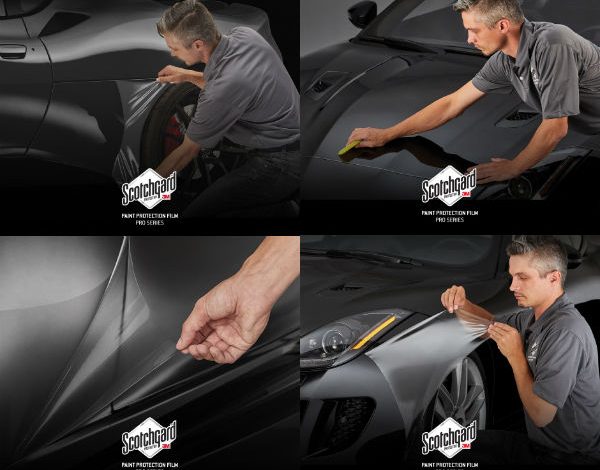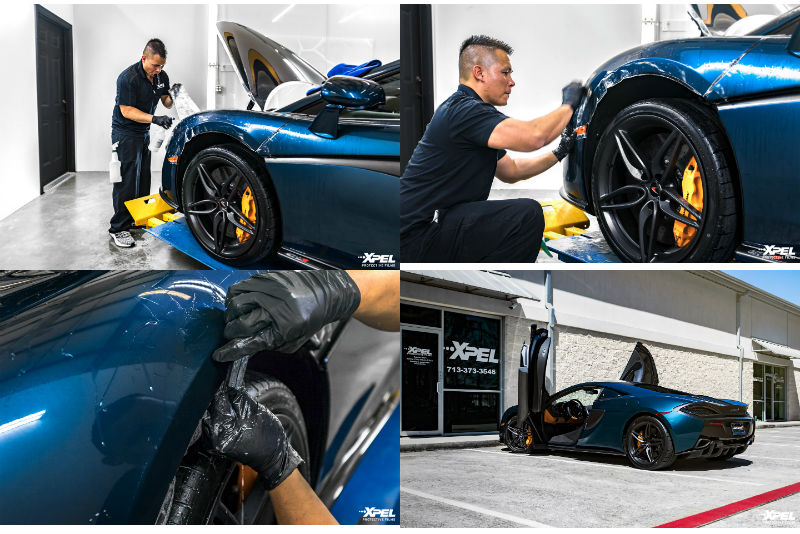More than Protection: Paint Protection Film
Find out what paint protection films bring to the table
Paint protection film is similar to wrap film in a few ways, but wrap shops wanting to get into the business need to be prepared with the right tools and proper techniques for achieving the perfect install of the material.
Paint protection film, or PPF, unlike films designed for vehicle wraps, is not meant to be printed on but protects a vehicle’s paint from scratches from contact with gravel, rocks and road salts and helps maintain the trade-in value. PPF, which is normally clear in appearance, offers protection against elements like magnesium chloride in Colorado, lovebugs in the southeast and sand in the southwest, plus road construction all over the U.S.
“The film is designed to protect the paint and keep it looking new,” says Eric Keller, national account manager for Xpel Inc. in San Antonio, Texas.
The uses of PPF
PPF, around for about 20 years, initially was installed on the forward-traveling and highly exposed parts of a vehicle, such as the front end, the edges of doors and the outside of mirrors, says Steve Wood, business development manager for Madico, a manufacturer of window film and tint products in Pinellas Park, Florida. In the last couple of years, customers started wanting to cover more areas of their vehicles or pay for an entire installation, he says.
“You put that over the paint, so it takes the abuse and you can remove and replace it, so it doesn’t damage the paint,” Wood says.
PPF and wrap film have different qualities in order to carry out different performances. PPF can be installed on top of wraps to provide an extra layer of protection for the material and graphics, while wraps are intended to add color and design that can’t be achieved with direct painting.
Made out of polyurethane, PPF has a softer surface and is more durable than vinyl wrap. Because of its cushion-like quality, it is able to absorb the impact from rocks and debris and return to its original shape.
“When you look at traditional wrap, vinyl by nature is fairly hard by comparison. It rips easily and doesn’t take the impact,” says Scot Smith, tech service representative for FLEXcon Co. Inc., a manufacturer of PFF products based in Spencer, Massachusetts. “The beauty of this product and the downfall of this product is you can’t see it. It will protect your paint indefinitely. It will never be scratched up. The downside is people don’t want to pay for something they can’t see. … You’re essentially buying an insurance policy.”
PPF has other qualities to protect the paint, such as a hydrophobic coating to repel water and prevent debris from sticking. It also is pliable, while wrap material is rigid.
“Polyurethane stretches a lot more than vinyl, so it’s easier to work with and get into curved areas,” Wood says. “When it stretches, it heals itself. It will absorb that surface stretch.”
PPF typically has a self-healing quality for quick recovery from minor scratches through heat or moisture, says Katie Johnson, global marketing manager for 3M, based in St. Paul, Minnesota. To activate that quality, exposing the vehicle to direct sun, pouring on warm water or going through the car wash are some options, she says.
The self-healing quality appears in the clear coat layer of PPF that often is made out of polyester. The clear or top coat has a glossy or matte appearance (resulting in a matte paint look), helps protect the paint from ultraviolet rays and is weather- and stain-resistant.
“The porosity of polyurethane allows dirt particles and impurities into it and will stain over time,” Smith says. “The top coat seals the pores in polyurethane.”
The layers of PPF
The top coat covers the polyurethane, which is thick to be able to handle the impact of debris and other objects. On the bottom side of the polyurethane is an acrylic mounting adhesive covered by a liner, also made out of polyester and removed during the installation process.
All three layers typically are 8 mil thick with 6 mil for the polyurethane and 1.5 to 2 mil for the adhesive, while vinyl wrap typically is 3 mil thick for everything.
“The adhesive is built so it can bond to the paint specifically,” Johnson says.
PPF comes in rolls with a cap sheet to cover and protect the material during transport and while it is in storage. 3M, for instance, offers rolls 12″ to 60″ in width; the smaller size comes in rolls of 100′, while the 48-60″-wide rolls only come in 50′ lengths, Johnson says.
Companies interested in PPF include wrap shops, window tint companies, auto body shops, detail shops, graphics installers and car dealerships wanting to increase their sales and diversify their product offerings.
“It’s just becoming a lot more popular, and the product has gotten a lot better. It’s a much more robust product,” Wood says, adding that initially, the product wasn’t as clear or as long lasting. “It’s also easier to install because it’s more pliable.”
Wrap shops in particular wanting to get into the business already have a base knowledge about the processes, tools and equipment that will help with installing PPF, says Laura Kvistad, senior marketing communications administrator for 3M.
“It’s easy for them to understand and pick up the technology,” Kvistad says. “It’s a perfect addition to their business to help grow their business further.”
The installation of PPF
PPF is installed as a wet application, versus vinyl that is installed dry. It is placed on the vehicle in two main methods, either as a kit or as a bulk installation.
The kit install typically is done with a plotter with a dedicated 45-degree blade and pattern-cutting software, Wood says. The material is cut to a design that fits around the parts of the vehicle, such as the mirrors, doors and hood, he says. There are thousands of design patterns to fit the different parts of a vehicle and vehicle types, he says.
PPF also can be applied as a bulk install by placing the raw material or the bulk roll directly onto the vehicle and physically cutting and trimming it to fit the individual parts, Wood says.
“Most people prefer kit over bulk installation, just because the kits are designed to fit the areas of the vehicle,” Kvistad says, adding that bulk installs are more difficult to work with to get the right dimensions. “It gives our installers more convenience and makes their jobs go much faster.”
Before doing the installation, the installer should make sure the vehicle’s surface is clean and free of debris and pre-fill any chips or scratches. The installer then can remove the excess material around each pattern piece and pull off the adhesive from the film, lining up the film to the exact dimensions of the vehicle part.
“This stuff will want to stick to itself,” Smith says, explaining that a slip solution needs to be sprayed onto the film and the working surface and even fingers before the film is laid onto the surface to prevent it from immediately sticking. “You can’t use too much of that slip solution.”
Wood recommends a slip solution consisting of 3 drops of Johnson’s Baby Shampoo and 32 ounces of water, but using more soap in warmer conditions and less in colder conditions. He also recommends a squeegee covered in the solution to help stretch and form the film to the vehicle parts.
“The soapy solution allows you to move it around until it’s tacked in place,” Wood says.
The solution helps the film float on the vehicle’s surface before it is in place, followed by a tack solution consisting of isopropyl alcohol and water to tack it down and adhere it to the surface.
The tack solution “helps the adhesive to become more aggressive,” Smith says. “It will allow the problem areas to stick down.”
A heat gun can be used to warm and soften the film and to get heat on the edges and make sure they are anchored in place. Or a pressure-on-demand steamer can provide a layer of instant steam to help form the material to the surface.
Once the PPF is installed, the care is easy, Wood says.
“You want to clean it the same way you clean your car,” Wood says. “You don’t have to do anything special to clean it.”
What can happen?
Errors can result in the installation process if the right steps are not taken, Keller says. The adhesive could dry prematurely as the film is stretched, or the film could be overstretched or not properly aligned, he says.
“This film is a thick version of Saran Wrap with adhesive underneath,” Keller says. “It can already start to set if you don’t know what you’re doing. It can distort. Anything that distorts will become visible to the customer.”
The adhesive, as it starts to set, will bond with the paint, Keller says, adding that in the case of the appearance of a microfiber fragment or a hair, the PPF materials can be picked up and set back down if done quickly.
“It’s easy if you set it down and pick it up, but if it’s sitting, it becomes harder,” Keller says.
The most important thing for installers is to get proper training, Keller says. Different manufacturers offer training classes that last about three to five days-installers should find out about the experience of the trainer, what is taught, how much hands-on experience there is and the kind of certification, he says.
“A wrap background is beneficial, but you need to understand the applications of this film,” Keller says. “It’s different, so get the right training. If you learn how to do this right and do it well, business will find you.”



